
|
||||||||
|
Seabirds include gulls, terns, albatrosses, petrels, shearwaters (mutton birds), cormorants, gannets and boobies. These seabirds spend much of their life roaming the oceans and marine environment looking for food and breeding. Many of the seabirds that live around Australian waters also spend much of their time over the open ocean and in other countries. There are more than 200 seabird species protected nationally under Australian law. Why are we concerned about seabirds? During the past, seabirds have been killed for their meat, eggs and feathers. Today, changes to breeding habitats, coastal development, oil spills, introduced feral animals and bycatch in fisheries are among the threats that impact on seabird populations. In Australia, more than 30 seabird species are listed as threatened, due to declining or small populations as a result of these threats. |
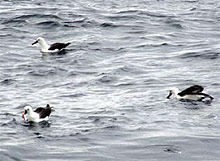 Albatross on the water. (Andrew Benton, courtesy AFMA) |
There is particular concern about albatrosses, petrels and shearwaters, which are at risk of global extinction through the influences of human activities. Of the 21 albatross species in the world, 19 are threatened with extinction. Australia has critical habitats for the breeding and feeding of albatrosses. Macquarie Island is listed as a critical habitat for the Wandering and Grey-headed Albatrosses. Albatross Island, Pedra Branca and the Mewstone are listed as critical habitats for the Shy Albatross.
The biology of albatrosses and petrels means their populations are unable to recover rapidly from impacts. Albatrosses and petrels live for many years, with some individuals known to live for more than 60 years. These species only breed after they are fully mature, which can take 5–12 years. And they only produce one chick at a time. Some species only breed every two years. Both adults care for the eggs for up to 85 days, they then feed the chick until it fledges, in some species this takes more than 300 days. Most albatrosses mate for life and if they lose their partner they may take years to find another, if ever.
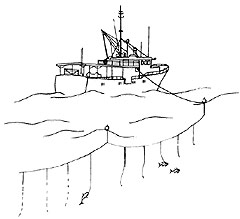 Diagram of an oceanic longline used to catch tuna and billfish. (Marine Matters Atlas courtesy BRS) |
How do seabirds and fisheries interact? Seabirds commonly feed on squid, fish and krill and are known to follow fishing vessels, aggressively competing for discarded fish and baits. The interactions between oceanic longline fishing and seabirds, particularly albatrosses and petrels, are of international concern. A longline consists of a main fishing line with numerous baited hooks attached to branchlines. Seabirds are accidentally killed by longline fisheries when they swallow baited hooks during the setting or hauling of the longline, or get tangled in the lines.
|
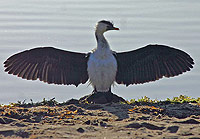 Cruciform Cormorant at Narrabeen Lakes, northern beaches of Sydney. (courtesy of Ian Sanderson via Flickr) |
How are Australian fisheries trying to prevent seabird bycatch in longlines?
|
International recognition of the need to address seabird bycatch in longline fisheries has been shown through the development of an International Plan of Action for Reducing the Incidental Catch of Seabirds in Longline Fisheries (IPOA — Seabirds) by the United Nations Food and Agriculture Organisation. Australia is implementing this international plan by developing a National Plan of Action (Seabird-plan). In Australia three of the principal threats to seabirds are listed as Key Threatening Processes — longline fishing operations, predation by feral cats, and competition and land degradation by feral rabbits. Threat abatement plans have been developed to address these threats. The Threat Abatement Plan for the incidental catch (or bycatch) of seabirds during oceanic longline fishing operations was revised during 2006 and outlines the steps oceanic longline fisheries will take to reduce seabird bycatch. Australian oceanic longline fisheries have changed the way they fish, to reduce seabird bycatch. Steps taken include:
|
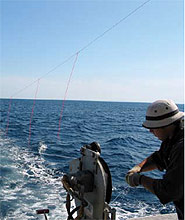 The bird-scaring line and streamers set off the back of the longline vessel, above where the hooks are being put in the water. These make it harder for the birds to get to the baited hooks. (Dave Cranston, courtesy AFMA) |
By using these measures seabird bycatch has been substantially reduced in some Australian fisheries. There is ongoing monitoring of seabird bycatch in longline fisheries to ensure the measures are working. Research also continues into other ways to avoid catching seabirds.
International support
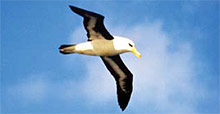 Black-browed albatross (courtesy AFMA) |
Conservation of species that roam the oceans, such as albatross and petrels, cannot be achieved by one country alone. Australia has encouraged other countries to work together to complement our national policies and actions. Perhaps the most important initiative taken is the Agreement on the Conservation of Albatrosses and Petrels (ACAP), Australia is a signatory and hosts the Secretariat. ACAP’s role is to encourage international cooperation and put in place conservation measures such as, reducing bycatch in fisheries, eradicating of feral species at breeding sites and preventing habitat loss. |
Find out more
|
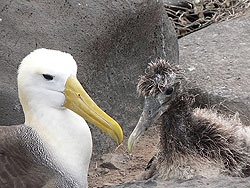 Albatross and chick (courtesy of James Preston via Flickr) |
Acknowledgements
This information sheet has been complied using the expertise and support from a number of sources. Background to the Threat Abatement Plan for the incidental catch (or bycatch) of seabirds during oceanic longline fishing operations, produced by the Australian Antarctic Division; The Department of the Environment and Water Resources Seabird website; The Agreement on the Conservation of Albatrosses and Petrels website.
